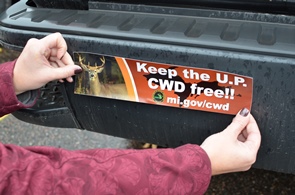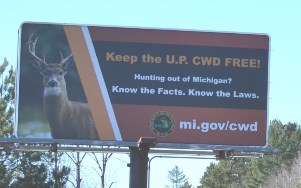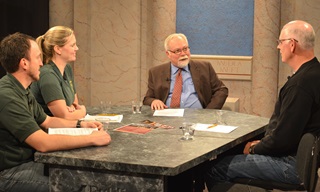The Michigan Department of Natural Resources has launched a public information and education campaign to try to keep chronic wasting disease from reaching the Upper Peninsula.
Discovered earlier this year in free-ranging deer in the Lower Peninsula, CWD affects the central nervous system and is fatal to white-tailed deer, mule deer, elk and moose. There is no known treatment.
DNR officials are concerned CWD could be brought into the U.P. by those hunting in other states.
From billboards and bumper stickers to an informational fact sheet and television and radio broadcasts, the DNR is working to inform the public about preventing CWD from occurring in the U.P.
“This is an insidious disease and it’s going to take partnership by all people concerned — hunters, DNR and other folks — to make sure that not only do we not get it, but if we ever do get it, that we don’t spread this disease across the peninsula,” said Terry Minzey, DNR U.P. regional wildlife supervisor in Ishpeming. “It can have long-term ramifications on our deer herd. While it may not impact us, it will certainly have impacts on our grandchildren.”
Chronic wasting disease first was discovered in Colorado in 1967. Mutated prions form small lesions in the brains of animals that cause death. In bovines, mutated prions can produce mad cow disease. There are no known CWD health risks to humans.
The disease may be spread by animal-to-animal contact. It also may be transmitted by contact with saliva, urine, feces, blood, carcass parts of an infected animal or soil.
CWD first was detected in Michigan in 2008 in a white-tailed deer at a privately owned cervid (deer, elk, moose) facility in Kent County.
In May 2015, a free-ranging white-tailed deer in Ingham County’s Meridian Township tested positive for CWD. A second CWD case — a 2-year-old male wild deer — was detected in July. In August, CWD was found in a 5-year-old doe. All three of those deer were located within a mile of each other.
Subsequent genetic testing showed all three infected deer were from the same family. The DNR and  Michigan Department of Agriculture and Rural Development set up a nine-township Core Area and a three county Management Zone around the area of the infected deer, placing various restrictions in effect.
Michigan Department of Agriculture and Rural Development set up a nine-township Core Area and a three county Management Zone around the area of the infected deer, placing various restrictions in effect.
Since then, more than 1,500 deer have been tested with no further cases of CWD discovered.
“Chronic wasting disease is a devastating disease and fatal, not only for the individual deer that contracts it, but also it’s devastating for a deer herd,” said Ashley Autenrieth, DNR deer program biologist in Gaylord. “That is why we are working so hard in southern Michigan right now to determine whether or not the disease has been established there. And if so, we will work just as hard to attempt to eradicate the disease.”
Dave Dragon, a DNR wildlife technician at the Crystal Falls office, worked previously in Wyoming, the place with the highest incidence of CWD in the world.
“In deer herds in which CWD is found, the herd usually ends up being dominated by 2 ½-year-olds and younger,” Dragon said. “This is due to the fact that deer that are infected with CWD rarely live beyond 2 ½-years old. This ends up being really problematic when you consider that up to around half of the deer population can be infected with CWD. So the effect is profound.”
Signs of CWD in deer include loss of body condition or emaciation, changes in behavior (including a loss of fear of humans), loss of bodily control or movements or excessive drooling and salivating.
Hunting generates more than $2.3 billion annually for Michigan’s economy. A healthy deer population is critical to the state’s economy. Last year in the U.P., more than 84,000 hunters harvested a total of 25,961 deer, including 19,431 antlered bucks.
Confirmed cases of CWD have been found in 23 states and two Canadian provinces. Hunters hunting in those areas could bring CWD back with them to the U.P., unless importation rules are followed.
 Wisconsin officials have confirmed CWD cases just 75 miles from Menominee and 115 miles from Ironwood.
Wisconsin officials have confirmed CWD cases just 75 miles from Menominee and 115 miles from Ironwood.
The Michigan DNR has erected billboards near the Michigan-Wisconsin border at Menominee, Norway and Ironwood, urging hunters who hunt out of state to know the facts about CWD and know the rules.
“To keep CWD from reaching the U.P., hunters need to educate themselves and they need to help educate others,” said John Pepin, DNR deputy public information officer in Marquette. “There are restrictions on bringing deer back to the U.P. from infected states and provinces, and dangers for the U.P. deer herd if these rules are not followed.”
The DNR has a great deal of educational information about CWD, including a fact sheet specific to the U.P. and information for taxidermists on the state’s Emerging Diseases Issues website at www.michigan.gov/cwd.
The information sheets and “Keep the U.P. CWD Free!” bumper stickers will be available from DNR offices and deer check stations across the region.
An upcoming broadcast of WNMU-TV13’s “Media Meet” will focus on CWD and keeping it from the U.P. The program initially will air at 6:30 p.m. EST Dec. 5 and be rebroadcast at 2:30 p.m. Dec. 6 and in January 2016.
Guests on the half-hour program include Autenrieth, Minzey, Dragon and Pepin.
The broadcast will reach viewers across the U.P. and parts of northern Wisconsin. A week after the initial broadcast, the television program will be available online athttp://wnmuvideo.nmu.edu/program/media-meet/.
Public Radio 90 also will air the program at 7:30 a.m. Dec. 6, repeating at 3:30 p.m. Dec. 7. The program also will be available on Public Radio 90’s podcast athttp://www.publicbroadcasting.net/wnmu/.jukebox?action=programs.
 Information on the education campaign also will be distributed to the DNR’s eastern and western U.P. Citizens’ Advisory Councils. The eastern advisory council formed a CWD subcommittee in April 2014 and produced a fact sheet of its own to distribute to various groups.
Information on the education campaign also will be distributed to the DNR’s eastern and western U.P. Citizens’ Advisory Councils. The eastern advisory council formed a CWD subcommittee in April 2014 and produced a fact sheet of its own to distribute to various groups.
“It was thought and hoped that the formation of this group would help the general public become informed as well,” said subcommittee chairman Tom Buckingham of Newberry. “Many of us on the subcommittee were keenly aware of the fact that once CWD arrives, it is virtually impossible to get rid of it.”
Buckingham warned of potential grave consequences.
“Due to the complexities of the U.P. deer herd — migration, supplemental feeding, predators — if CWD arrives, it could very well mean the end of deer hunting in the U.P. as we now know it,” he said.
Buckingham said the best offense is to raise public awareness on deer-handling procedures and other concerns, and try to keep infected animals from being brought to the U.P. from outside the state.
For more information, visit www.michigan.gov/cwd.
 Keweenaw Report Your Source for Local News and Sports
Keweenaw Report Your Source for Local News and Sports






